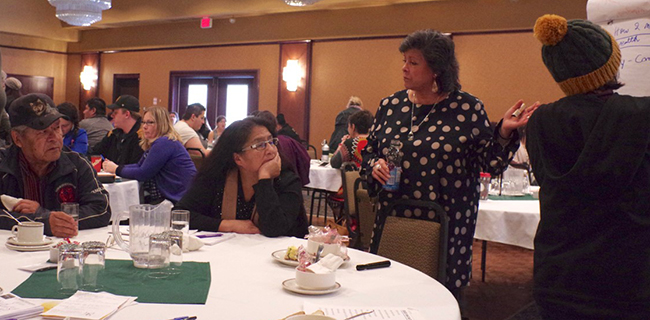‘We are an industry’: Wesley-Esquimaux says at Indigenous Knowledge Conference

By Rick Garrick
THUNDER BAY – Reconciliation and Fort William First Nation’s Sugar Bush were among the topics featured at the Indigenous Knowledge Conference, held Nov. 15-16 in Thunder Bay.
“We are so deeply embedded in the economy of Canada that we are an industry,” says Cynthia Wesley-Esquimaux, chair on truth and reconciliation at Lakehead University and a Chippewas of Georgina Island citizen, during her presentation on Reconciliation. “The Indian residential schools became an industry, reconciliation is becoming an industry, everything we touch turns to gold. Except it never touches us, and that is really the biggest issue that we have.”
Wesley-Esquimaux noted a comment from an Elder who described the example of a small jail in Alberta that had a vast majority of Indigenous inmates. Although a new facility had been built in Edmonton, the warden in the jail refused to send the inmates to the new facility because the jail would close and the staff would lose their jobs and not be able to pay their mortgages.
“That’s how deeply embedded in the economy we are,” Wesley-Esquimaux says. “And up here it’s no different. Just walk across the top of this province, in Dryden, Kenora, Thunder Bay, who’s in our jails.”
Wesley-Esquimaux also raised the need for more Indigenous staff in organizations and companies.
“It’s not good enough to hire an Aboriginal advisor,” Wesley-Esquimaux says. “You need to hire Indigenous people in administrative positions where they have the authority to make decisions and actually implement change. If you do not do that, you are not doing your job and you are not doing reconciliation.”
Fort William citizens Stephanie MacLaurin and Helen Pelletier spoke about their connections with the sugar bush during the Sugar Bush presentation.
“As Indigenous people we talk a lot about land and its connection,” MacLaurin says. “There was a time when I didn’t really understand that so I did not feel the connection, so connecting to the sugar bush in the last four or five years has really helped (me) understand and foster that love for the sugar bush and as an Anishinabe woman what the sugar bush means to me.”
Pelletier spoke about how a community Elder used to make maple syrup from the sugar bush when she was a girl, but over the years the maple syrup production stopped and the road to the sugar bush was blocked off.
“It was about five years ago when our cousin woke up our maple spirits, mine anyways for sure,” Pelletier says. “And woke us up and realized that we had to develop that relationship again with the land and the trees.”
Pelletier says she has since developed a strong connection with the sugar bush.
“When I take children up there, I tell them they are going to visit their grandmothers because the trees are water carriers,” Pelletier says. “I have such a respect for (the maple trees) that I’ve now realized they are citizens of our community.”
The conference also featured a keynote address by Leroy Little Bear, from the University of Lethbridge.
“I’ve heard Leroy speak many times about multi-verse as opposed to the universe and about science opposed to Indigenous knowledge,” Wesley-Esquimaux says. “I think it is a very important message — it gives people a sense of pride that their knowledge, their on-the-land knowledge, their observations, their grandfather’s lives, were valid and important and scientific. They were doing research just by virtue of understanding their environment and being able to survive for thousands of years on the land.”


